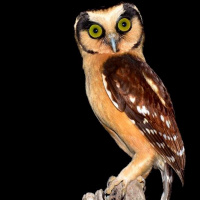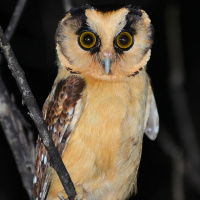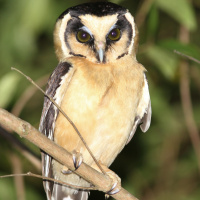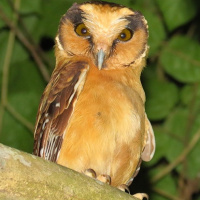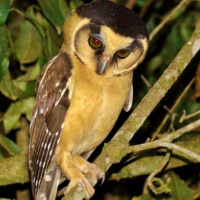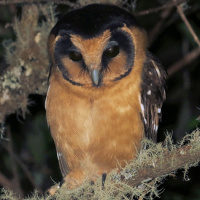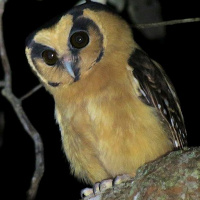Introduction
The Buff-fronted Owl is an small colourful owl with no ear-tufts, a short tail and round head. The species name harrisii was named for American ornithologist Edward Harris.
Photo Gallery (7 pictures)
Sound Gallery
Information
Description: The facial disc is round, with a narrow blackish rim, and bordered buffish. There are areas of blackish-brown from the top of
each eye to the edge of the disc, bordering the ochre-buffish forehead. Eyes are yellow. Cere is yellowish-grey and the bill is yellowish to pale bluish-green.
The chin has a dark brown or blackish bib that nearly merges into a thin blackish rim. The crown is blackish-brown. The mantle and back are dark chocolate-brown
with a few rounded white and buffish spots. There is a narrow buffish-ochre nuchal collar, contrasting with the darker back.
Scapulars have several large buffish-ochre spots on the outer webs. The wings have whitish, rounded spots.
The tail is blackish with a white tip and two visible rows of rounded white spots on each web of feathers.
Breast and belly are plain yellowish-tawny to ochre-buff.
Tarsi are feathered to the base of the toes, which are bare and pale yellow with dark brown claws.
Size: Length 19-21cm. Wing length 142-167mm. Tail length about 80mm. Weight 104-155g.
Habits: Little known. The Buff-fronted Owl is an unsociable and nocturnal bird.
Voice: The male's territorial song consists of very rapid high-pitched trills with a 'quivering' character uttered in very rapid staccato
(15-16 notes per second) and lasting about 7-10 seconds - Gurrrrrurrrrrrrurrrr. The general character of the call is somewhat irregular and wavering, as
the phrase increases and decreases in volume.
A soft, single, high-pitched u call is probably a contact call.
A short series of accelerating staccato notes falling in pitch (bouncing ball call) seems to be an alarm call. It is often preceded by single, upward-inflected
hoots with a wailing character - bu bu-bu-bubububub.
The female give a thin, very high-pitched tseet when calling for her mate for food.
Hunting & Food: Little known, probably feeds on small vertebrates and larger insects.
Breeding: The breeding habits of the Buff-fronted Owl are poorly known. The breeding season seems to vary according to climatic conditions. Nests are in tree cavities, especially woodpecker holes, of varying height above the ground.
Habitat: Primarily montane and cloud forest alternating with clearings and pastures, up to near timberline: wooded areas up to 3000m. Also occurs at lower altitudes in dense forest with tall trees and dense undergrowth.
Distribution: Scattered and patchy distribution throughout South America.
The Andes from Venezuela to Ecuador and southward on the eastern slope to Northern Argentina.
Also records from eastern and southern Venezuela.
Patches in eastern Brazil, as well as southern Brazil extending into northern Uruguay, northeastern Argentina and eastern Paraguay.
It seems likely that there are populations yet to be discovered.
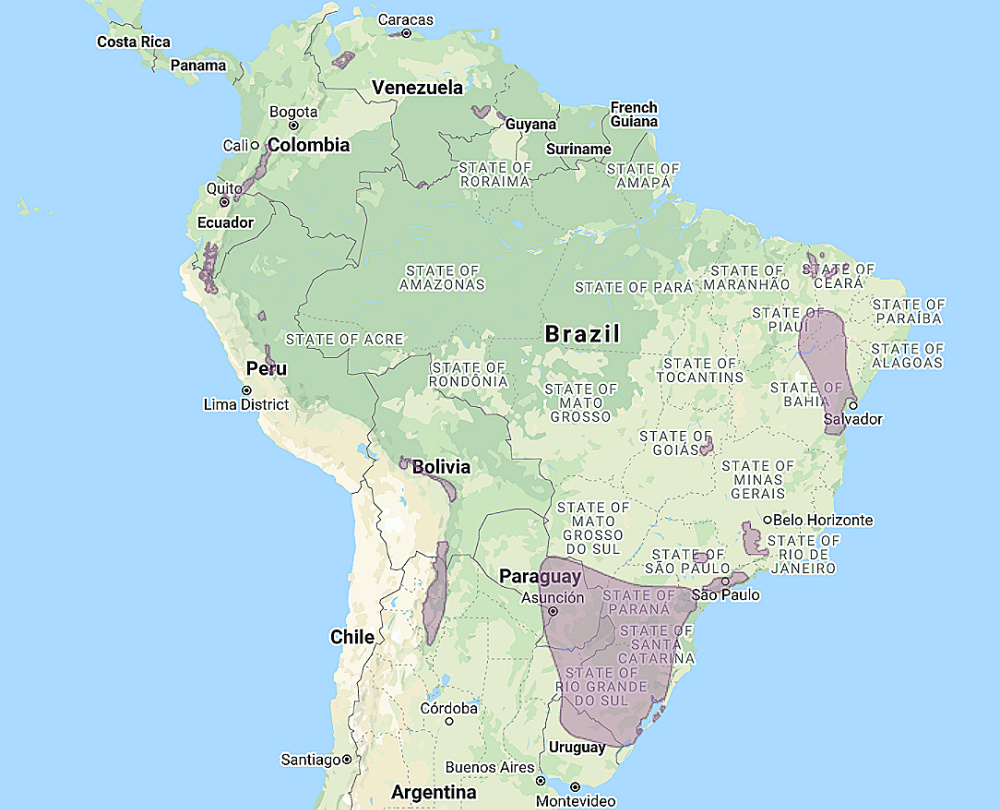
Range of the Buff-fronted Owl Aegolius harrisii
Status: Listed as 'Least Concern' by Birdlife International.
Original Description: Cassin, John. 1849. Proceedings of the Academy of Natural Science of Philadelphia (Proc. Acad. Nat. Sci. Philadelphia) 4 (1848): p. 157.

